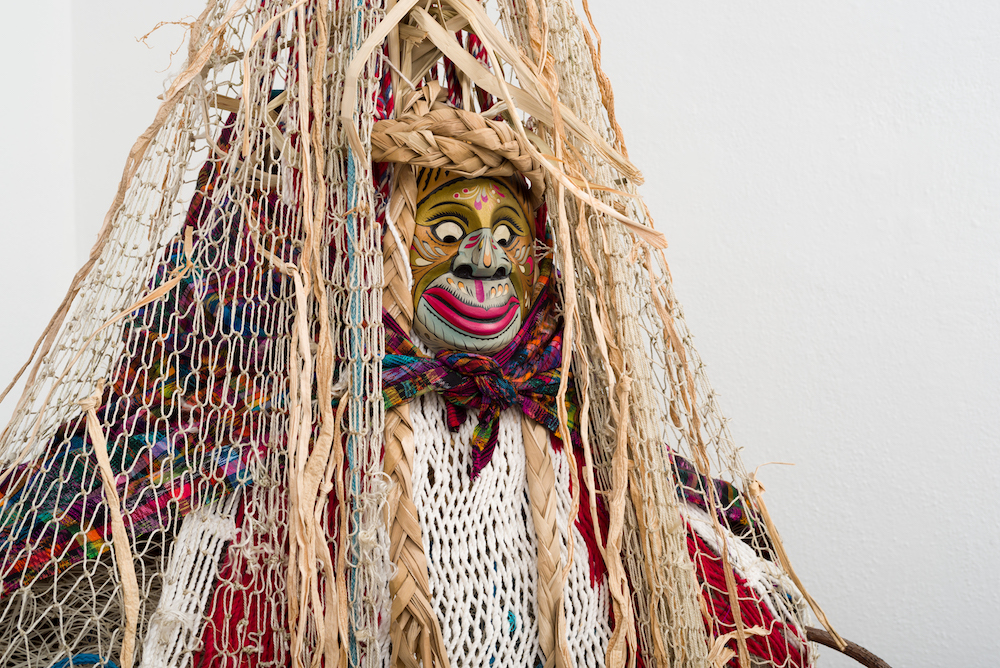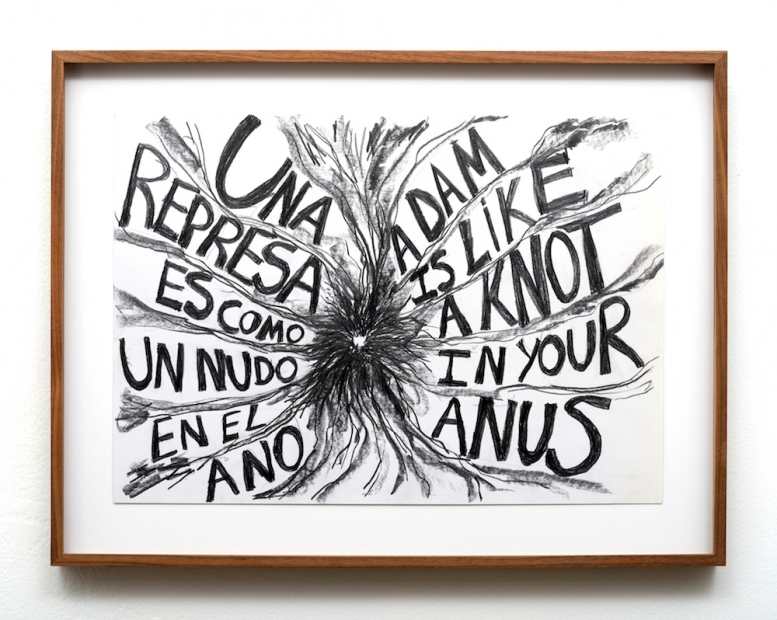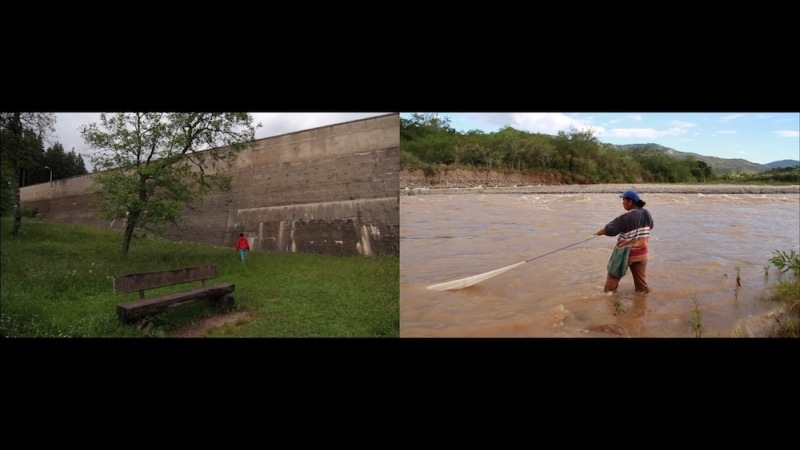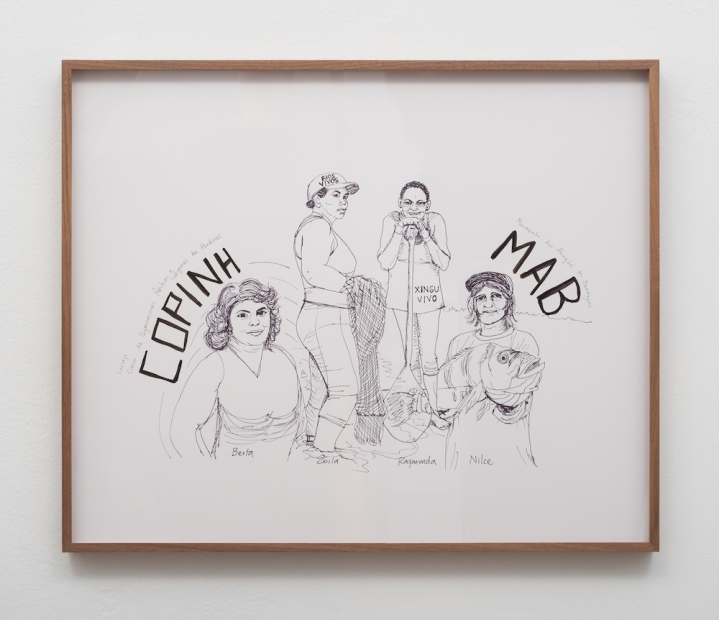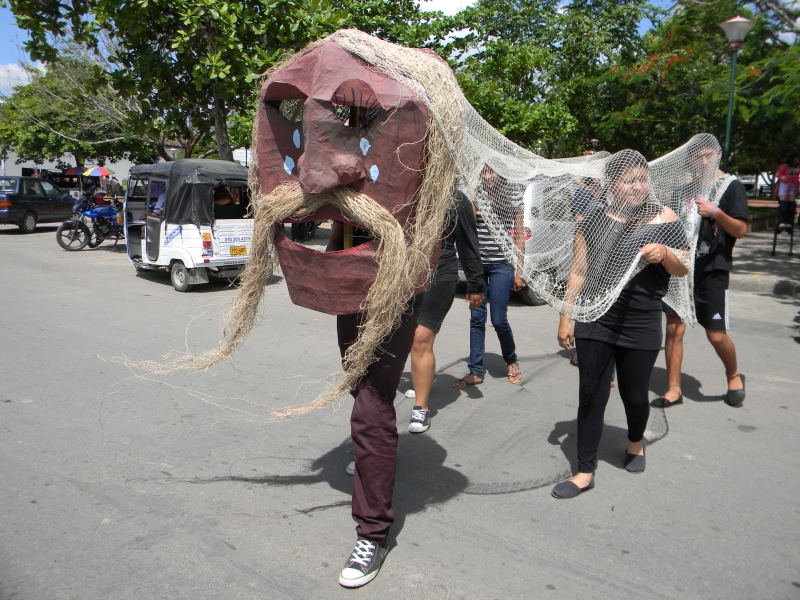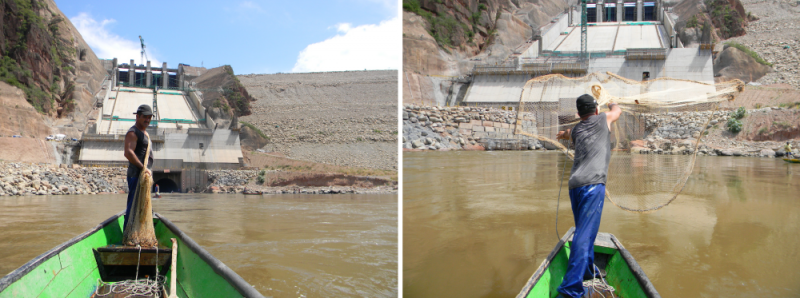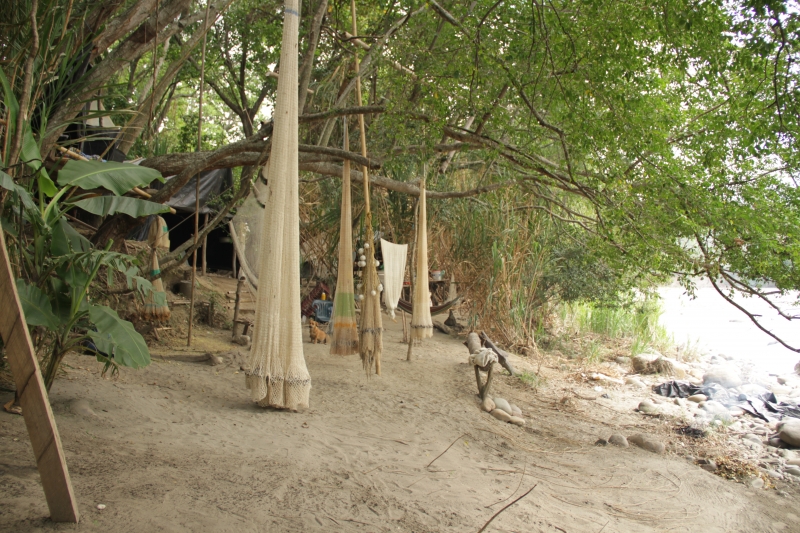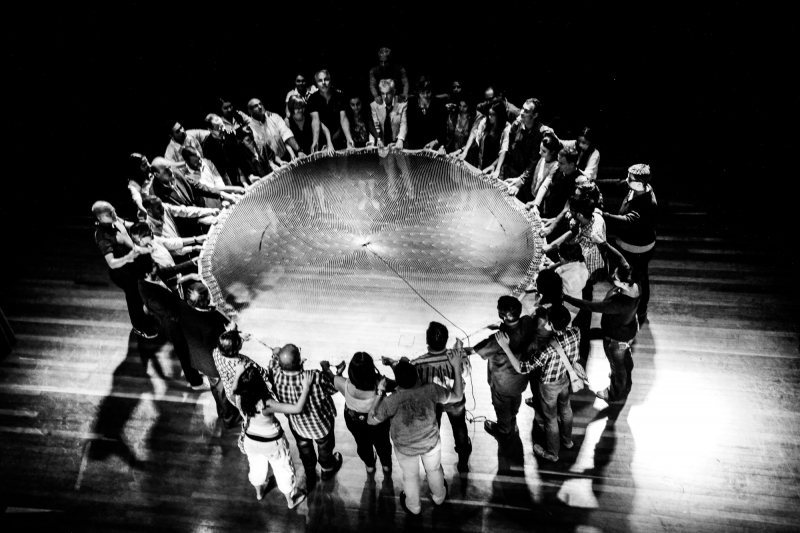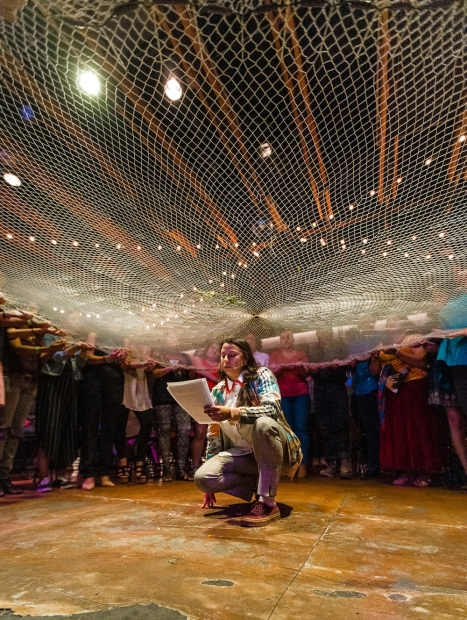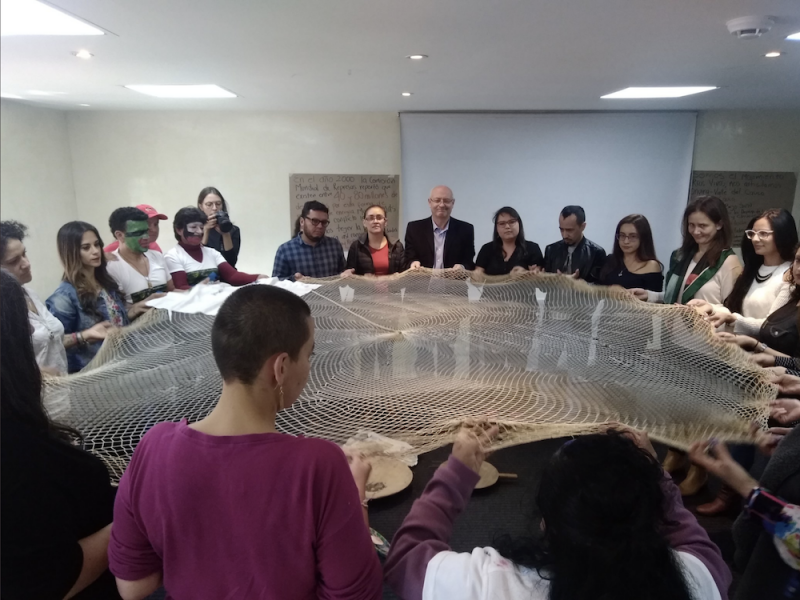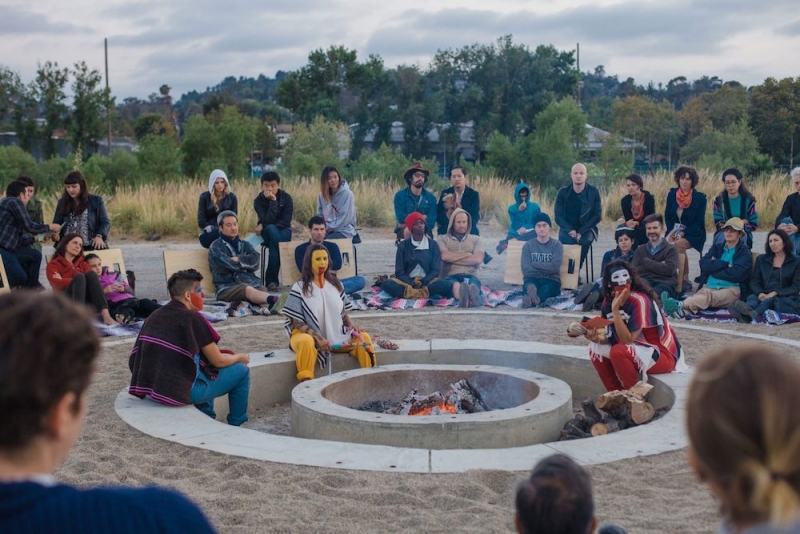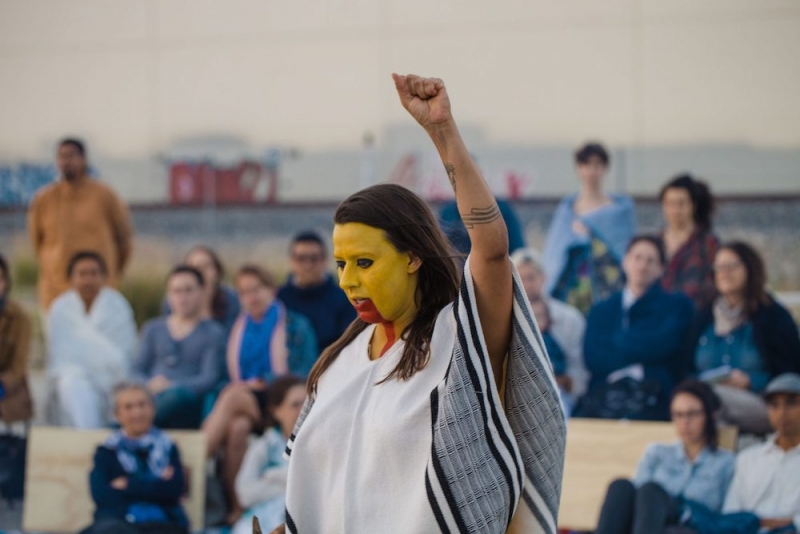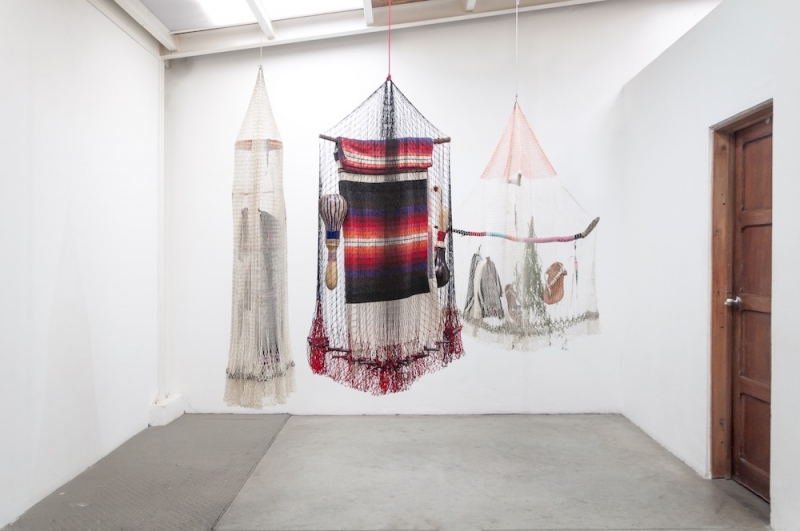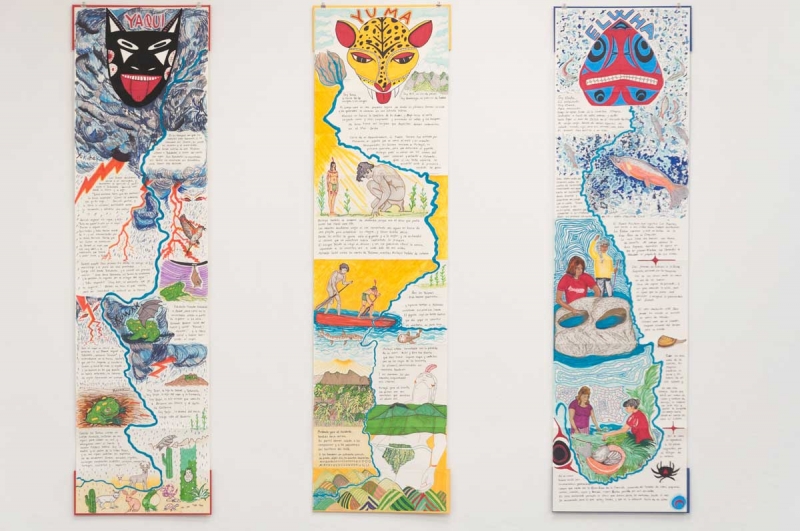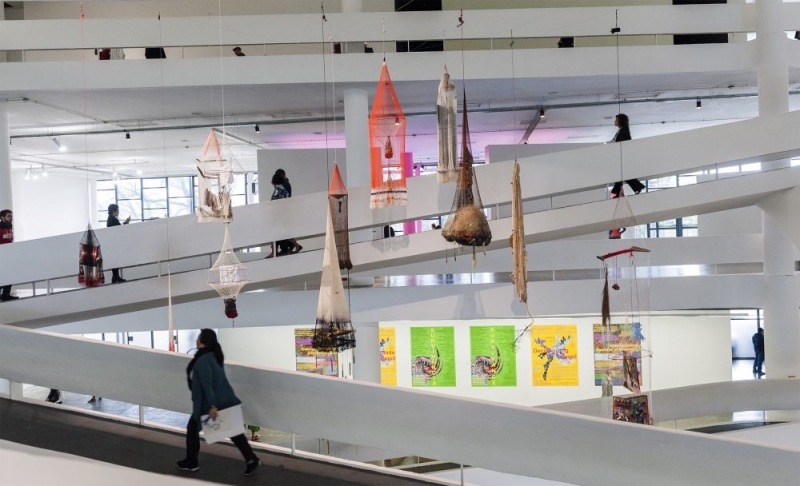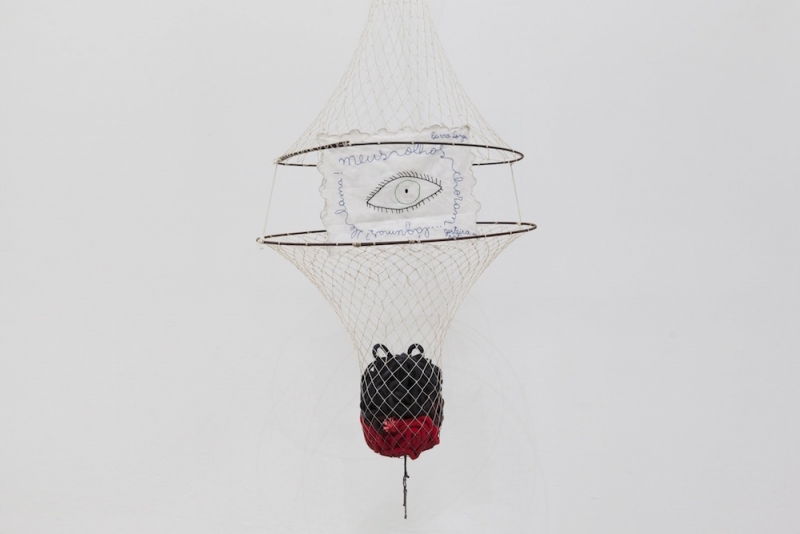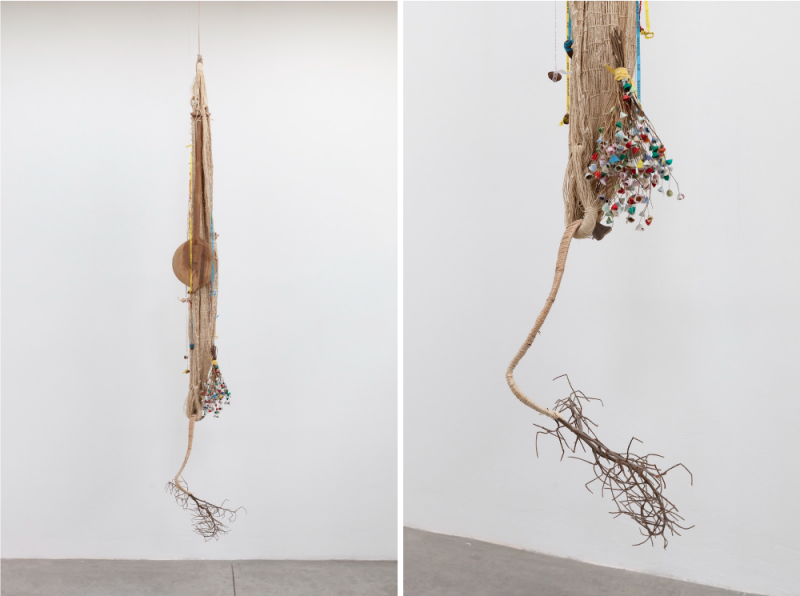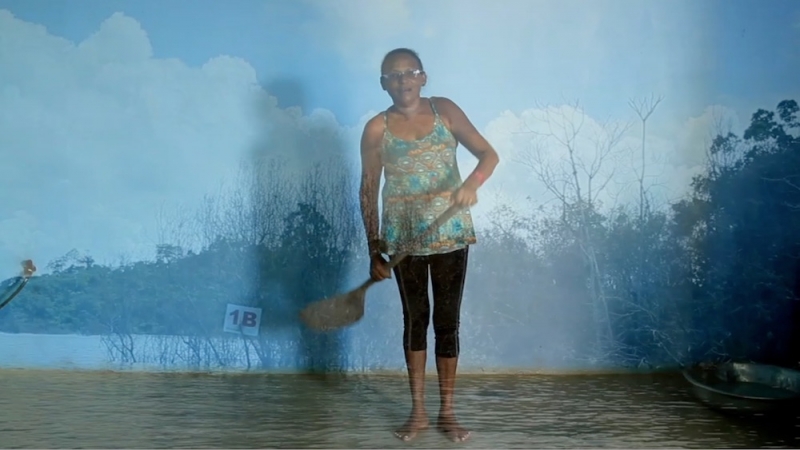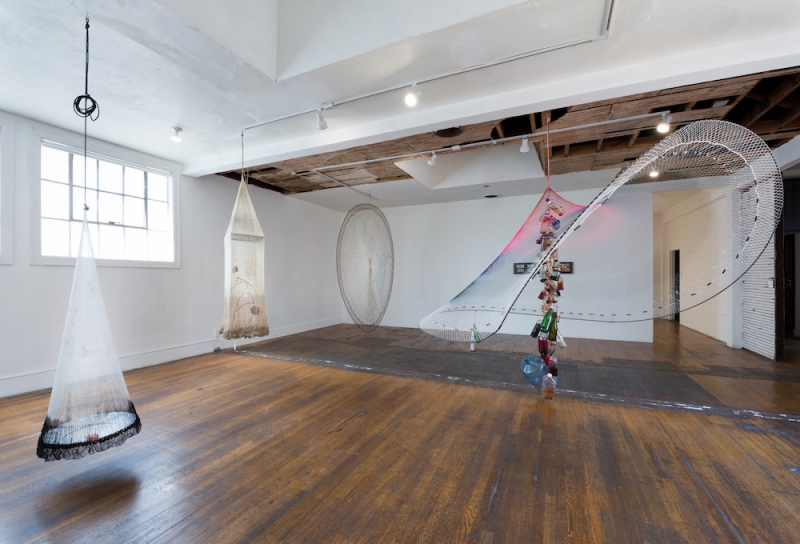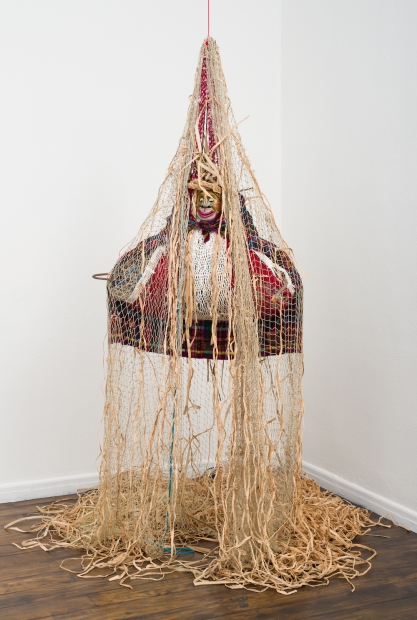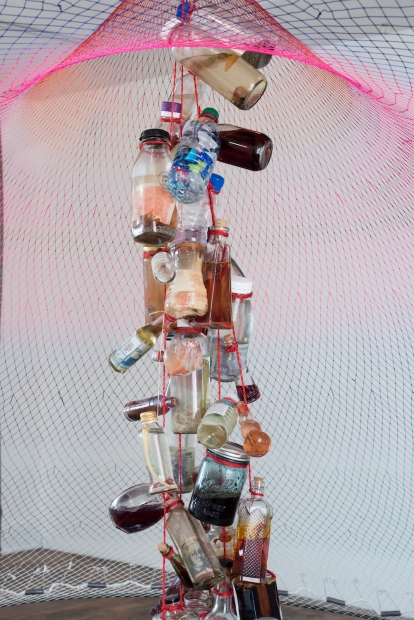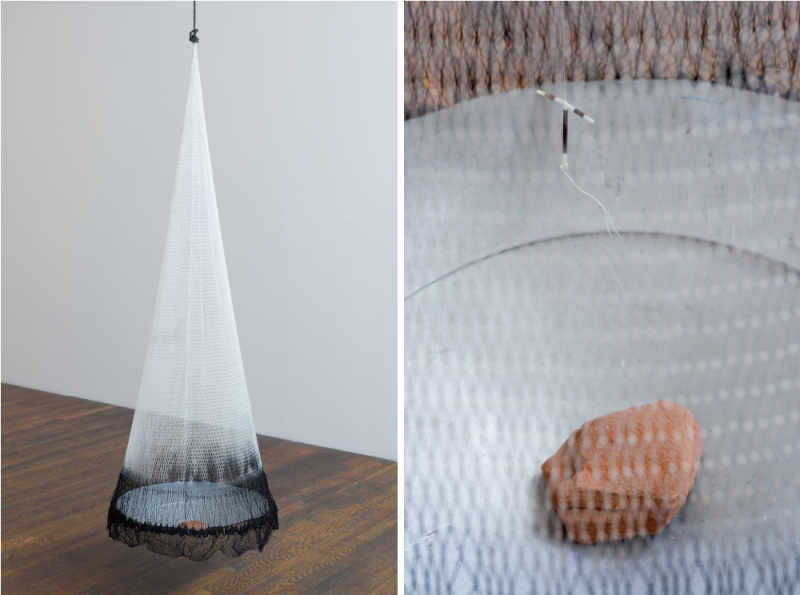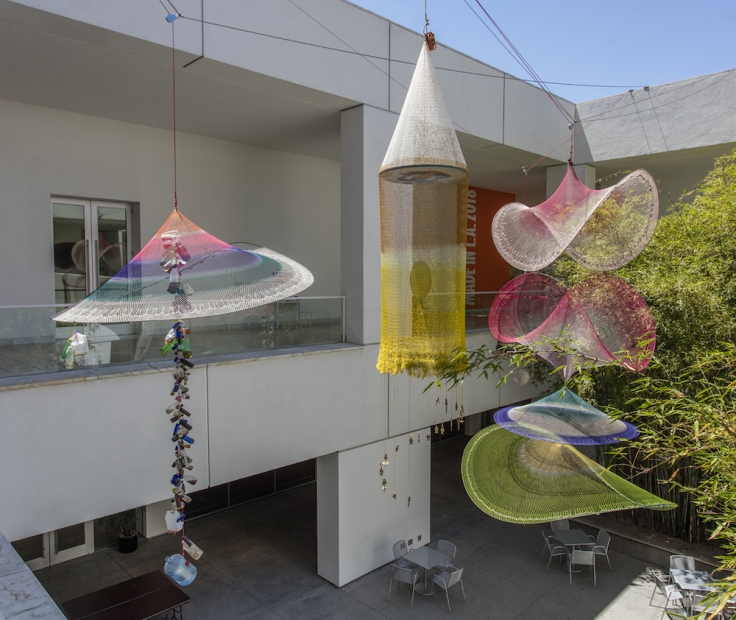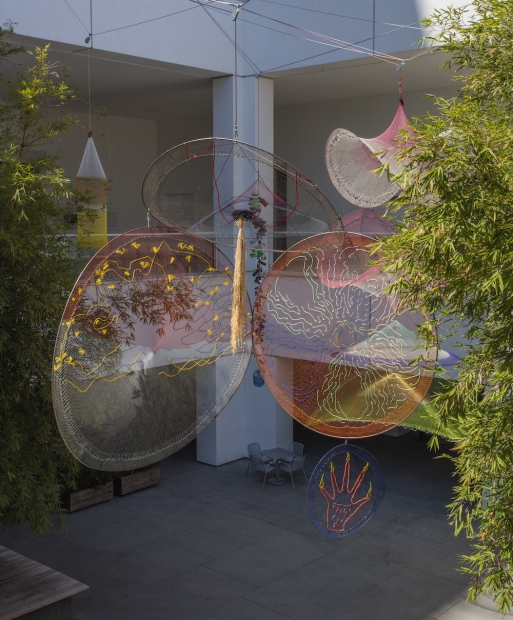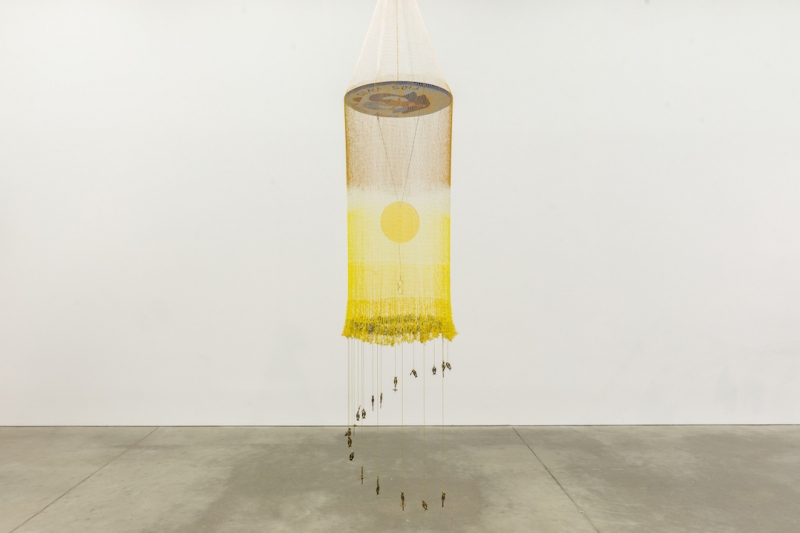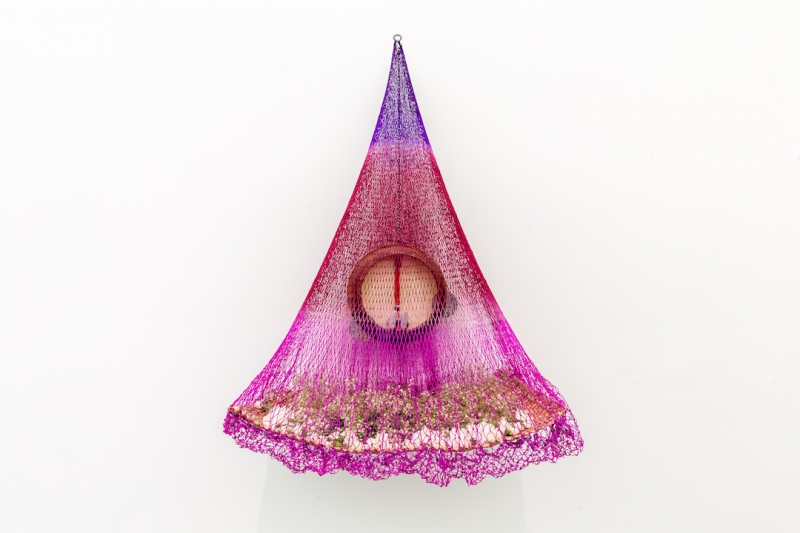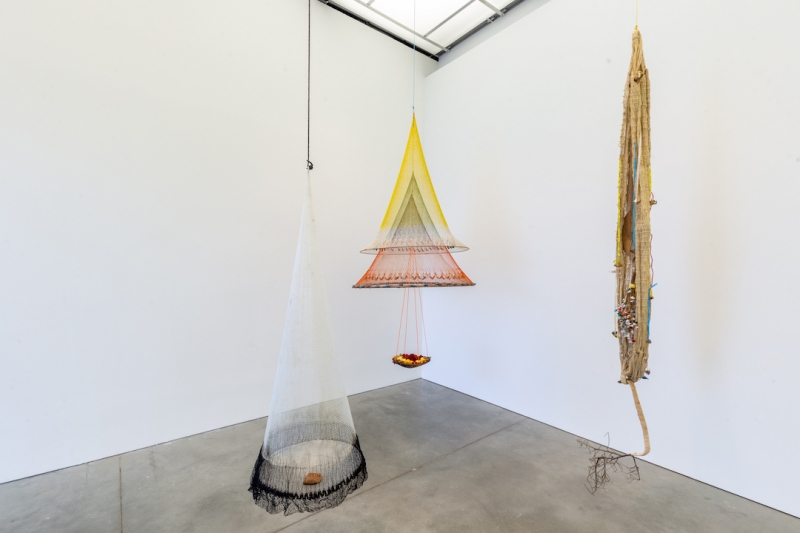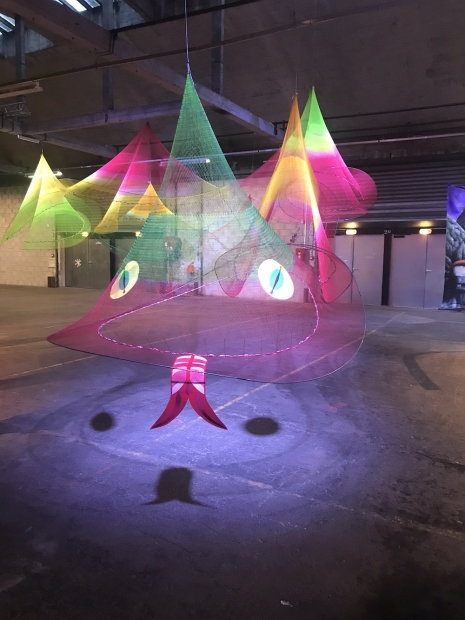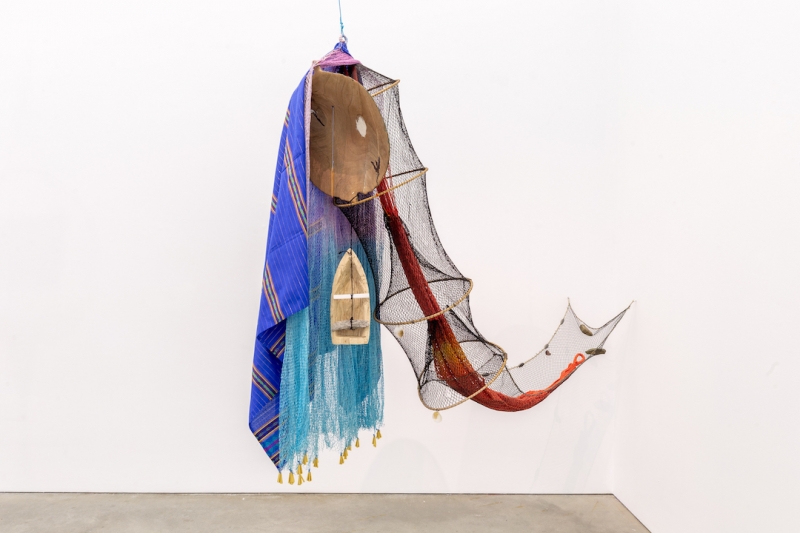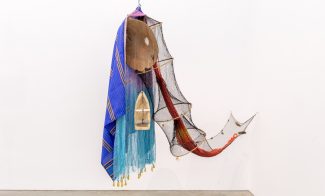Be Dammed
Indigenous cosmogonies throughout the Americas understand water to be the sacred essence of life. All bodies of water are interconnected—rivers are the veins of the planet, drawing together different communities and ecosystems. Rivers, like all bodies of water, are living entities, and as such, are subjects rather than objects. As the effects of climate change are more widely acknowledged, many have turned toward such indigenous knowledge in the effort to foster healthier relationships to the environment and non-human life. In the twenty-first century, water is already one of the most disputed natural resources. In the United States, water protectors protested against the Dakota Access Pipeline at Standing Rock Indian Reservation, united by the slogan “Water is life.” The water protectors active in the Dakotas stood in solidarity with individuals and groups across the world demanding fair access to water and those experiencing water insecurity. Around the same time, in several Latin American countries (following a historic ruling in New Zealand), national governments began to grant rivers and other natural bodies environmental personhood, “a nascent notion of designating parts of nature as legal persons entitled to independent regard and considerations.” 1 Ecuador’s 2008 constitution, for example, proclaims the rights of nature “to exist, persist, maintain, and regenerate its vital cycles.” 2 In 2010, Bolivia passed the “Law of the Rights of Mother Earth,” designating Mother Earth “a collective subject of public interest.” 3 After illegal mining in the Atrato River Basin in northwestern Colombia produced devastating natural and humanitarian impacts, the Colombian Constitutional Court declared in 2016 that the Atrato River possesses rights to “protection, conservation, maintenance, and restoration.” 4
This historic ruling came only a few years after a “Master Plan” for the development of the Magdalena River was signed by the Colombian and Chinese governments in 2014. The Magdalena is Colombia’s largest and most important river, stretching nearly 1,000 miles from the mountainous region in the southwest near Ecuador to the Caribbean Sea in the north. 5 Along with other provisions, the “Master Plan” called for the construction of up to fifteen hydroelectric dams on the Magdalena, in addition to one other dam constructed in 1987 and another under construction since 2011. Activists against the construction of new hydroelectric dams on the Magdalena point out that they are not necessary, as Colombia already produces enough energy to meet domestic demands from hydroelectric power generated from other major rivers, plus surplus power it exports to Venezuela, Panama, and Ecuador. 6 Nevertheless, in the wake of fifty years of conflict in Colombia, foreign development raced to extract resources from the Magdalena. 7
It is against this backdrop that the Los Angeles-based, Colombian artist Carolina Caycedo (b. 1978, London) initiated her ongoing project Be Dammed in 2012, to examine the wide-reaching impacts of dams built along waterways, particularly those in Latin American countries. The aims of this project are to explore, as she says, “how infrastructures of an extractivist nature… affect social bodies and bodies of water.” 9 Caycedo was raised in the greater Magdalena River Basin and frequently returns to Colombia where she is an active member of Rios Vivos Colombia Social Movement and is involved on a national and international level in movements of solidarity in the struggle for water, land, and life. In 2012, more than 250 large hydroelectric dams were planned or under construction by transnational corporations across Latin America, signifying the transition of bodies of water from public entities to privatized resources. Simultaneously, the United States is the leading country in dam removal, allowing for the restoration of river ecosystems. Around 900 dams were removed in the U.S. between 1990 and 2015. These cursory details demonstrate the asymmetrical power relations and disjunctive modes of governance at work between countries and multinational corporations in the so-called Global North and those in the so-called Global South, where forms of colonial violence and oppression are still in operation.
Be Dammed takes several different forms—from workshops and collective actions that Caycedo refers to as “geochoreographies,” to a series of large-scale photographic Water Portraits, to an accordion-style artist’s book called Serpent River Book (2017). Many of the projects in Be Dammed incorporate indigenous forms of knowledge. Each project grows organically out of what Caycedo refers to as “spiritual fieldwork” and her intimate and ongoing relationships with individuals and groups in different riverine communities adversely affected by the privatization of waterways. For her research, Caycedo “blend[s] into the local and regional agendas, keeping aesthetic intention and art production in the background.” 9 She then “proceeds to visit, record, collect objects, and create friendships with people who live and work there, sharing the intimacy of homes, places of work, and spaces dedicated to direct action, learning, and collective celebration.” 10 Many of the individuals she met doing fieldwork are recurring figures in her work, such as a fisherwoman, day laborer, and community organizer from La Jagua, Colombia named Zoila Ninco or Don Élio Alves da Silva, a fisherman displaced by the Belo Monte dam on the Xingu River in Brazil. Whereas dams in many parts of the world have been “naturalized” in some ways and are commonly viewed as benign, the incursion of multinational corporations to build dams in Latin America has been met with protest. Kogui indigenous spiritual leader Mamo Pedro Juan, who passed away in 2017, described a dam as severing the connection between bodies of water and communities, “like a knot in the veins, or, still worse, a knot in the anus.” 11 The opposition to dams by activists, farmers, fisherfolk, and others has been persistent, even while Colombia is consistently found to be in the top three nations globally for murder rates of environmental defenders.
Be Dammed is directed at constructing what Caycedo refers to as a “popular historical environmental memory” that might produce embodied forms of everyday knowledge and counternarratives to the dominant ideologies of multinational corporations and destructive tendencies of extractive capitalism. In the context of environmental personhood, and by telling the stories of those affected, Caycedo’s work proves vital in the documentation and aesthetic mediation of urgent issues related to a “collective subject of public interest” and in its multivalent aesthetic strategies intended to resist and counteract toxic ideologies and repetitious cycles of dispossession and violence.
This multimedia essay traces the genealogy of the cast fishing net, or atarraya in Spanish, in Caycedo’s practice—a resonant object that appears first in her videos and performances before she produces a series of hanging sculptures called Cosmotarrayas. One component of Be Dammed, the Cosmotarrayas are assembled with handmade fishing nets and other objects collected during her field research in riverine communities. This essay accompanies Caycedo’s 2020 solo exhibition at the Institute of Contemporary Art/Boston, which marks the culmination of the Cosmotarrayas. The rich story of the cast fishing net in Caycedo’s work, one that interweaves specific people, rivers, traditions, and cultures, is recounted here through text, video, audio, images, documentation, and storytelling. The Cosmotarrayas are deeply symbolic objects, and reinforce Caycedo’s tenet that, “to cast a fishing net affirms the river as a common good.” 12
Spaniards Named Her Magdalena, But Natives Call Her Yuma
The cast fishing net first appeared in Caycedo’s work in the two-channel video essay Spaniards Named Her Magdalena, But Natives Call Her Yuma (2013). Made during a DAAD residency in Berlin, Spaniards Named Her Magdalena, But Natives Call Her Yuma juxtaposes footage of dams and reservoirs in Germany with Caycedo whispering a bilingual narrative about her relationship to rivers and how dams become “naturalized” over time. Renamed Magdalena in 1501 by the Spanish during their colonization of the Americas, the river was first called Yuma, which means “land of friends,” by the Muisca confederation several centuries earlier, a name still in use by local inhabitants. During her field research, Caycedo interviewed a broad range of individuals either affected by or involved with the development of the controversial El Quimbo Hydroelectric Project in the Huila Department. El Quimbo was the first hydroelectric power project to be constructed in Colombia by a multinational corporation, the Spanish hydroelectric utility company Endesa via its Colombian subsidiary Emgesa. This massive concrete faced rock-fill dam radically diminished fish populations, compromising the economic autonomy and food sovereignty of riverine communities who depend on the Magdalena for their way of life. 13
In addition to an activist, an environmentalist, an opposition leader, a professor, a shaman, and the dam’s engineer, Caycedo interviewed local fisherwoman Zoila Ninco. Ninco was interviewed for a brochure produced for Caycedo’s 2013 exhibition The Headlong Stream is Termed Violent, but the Riverbed Hemming Is Termed Violence by No One at DAAD Gallery in Berlin where she is identified anonymously as “Fisherwoman.” In Spaniards Named Her Magdalena, But Natives Call Her Yuma, Zoila Ninco stands on the banks of a rushing river on the right, next to footage of stagnant water in a German reservoir on the left. Later in the video, Zoila Ninco appears again casting her fishing net, alongside footage of Caycedo herself trying to scale the wall of a German dam. Zoila Ninco features in other videos, drawings, and performative actions, and her family even provided many of the cast fishing nets used for the Cosmotarrayas, including the nets for the first three sculptures produced in 2016.
Land of Friends
Carolina Caycedo, Land of Friends, 2014. HD video (color, sound; 38:10 minutes).
Caycedo continued her critical focus on the Magdalena River, colonial histories, and the El Quimbo Hydroelectric Project in the video essay Land of Friends (2014), which expands upon the artist’s multiperspectival approach in novel ways. 14 Whereas Spaniards Named Her Magdalena, But Natives Call Her Yuma features a bilingual first-person narrative whispered by Caycedo herself, Land of Friends features the voices of many of the individuals interviewed in the fieldwork for the earlier video as testaments. Activists, politicians, fisherfolk, engineers, farmers, and Caycedo’s own family feature, as do the “submerged” 15 perspectives of non-human agents—the baby armored catfish, the firefly, and the leaf cutter ant. The central protagonist of Land of Friends is the Magdalena itself. Through various methods, like the use of satellite imagery, long shots of the river’s movement and surrounding environment, its sound, and its voice, Caycedo portrays the river as a living being. Zoila Ninco appears on the banks of the Cuacua, or Suaza, River, with her net, repeatedly casting and pulling back in as Caycedo describes who she is, before unspoken text captions compare her to Cacica Gaitana, “a political and religious leader that in 1539 unified several indigenous tribes to defend the Huila territory from the Spanish conquest.” It is in witnessing Zoila Ninco perform this repetitive gesture, and in thinking about the river’s history, that Caycedo becomes fascinated with the cast fishing net as an affective object. For Caycedo, the material qualities of the fishing net—they are porous, malleable, handmade, and embody ancestral knowledge—offer a potent counterpoint to the brute-force infrastructure of dams, which disrupt the natural flow of rivers, dispossess people of their homes, and threaten their way of life.
Geochoreographies
In addition to her video works, Caycedo also developed an aesthetic strategy she refers to as geochoreographies, workshops and radical collective actions that use the body as a political tool, guided by performative methods developed first by Augusto Boal as part of his Theatre of the Oppressed. According to Caycedo, “a geochoreography is an everyday gesture that is intrinsic to a specific geography and is constantly performed in relation to the immediate environment, such as casting a net or washing gold in the riverbank.” 16 Cast fishing nets first featured in a series of workshops and collective actions Caycedo developed in collaboration with Jaguos por el Territorio Collective from July to December of 2014 with communities affected by El Quimbo. In this action, the fishing net was employed to create a series of large-scale puppets, as well as a series of choreographies where several fisherfolk cast their nets into the Yuma in a coordinated way. The presence of the net in this collective action prefigured a later iteration of the geochoreographies centered on the physical and conceptual power of the fishing net as a visual symbol.
Huila’s Bleeding
Carolina Caycedo and Jonathan Luna, Huila’s Bleeding, 2014. HD video (color, sound; 12:00 minutes). Commissioned by Creative Time Reports.
Commissioned by Creative Time Reports and made in collaboration with local activist Jonathan Luna, founding member of the Jaguous por el Territorio collective, the social documentary Huila’s Bleeding (2015) captures the extent to which the way of life of those living along the rural banks of the Magdalena is threatened by El Quimbo. In a critical segment, Antonio Chavarro, from La Jagua, is shown weaving a net and explaining how the everyday activity of fishing to bring food to the table was threatened by the privatization of the river. In the segment, the particular relationship of a net to an individual’s body is readily apparent. Later, Carlos Wilfredo Hernandez, who participated in Geochoreography Domingo Arias, explains that he has been displaced twice by dams on the Magdalena River without compensation. The interview was conducted in front of his shack on the riverbank, and the way that his fishing nets hang from the trees to dry became an important reference for the construction and display of Caycedo’s Cosmotarrayas.
Atarraya
Atarraya is a performance and adaptable script that assembles diverse human and non-human voices, both living and dead entities impacted by water infrastructures. A single orator articulates and gives form to these voices, while another individual casts a fishing net repeatedly into empty space. At the conclusion of the performance, the audience is invited to hold and stretch out the net as a gesture of solidarity with the entities represented in the performance. A photograph captures this climactic moment of each Atarraya performance, and is distributed online as a copyleft image via social media.
Carolina Caycedo, Atarraya, 2015. Performance documentation, Feria Internacional de Arte de Bogotá, Colombia, 2016.
In addition, Atarraya has been adapted by grassroots movements like Rios Vivos Colombia, to help frame the relationship of environmental and armed conflict in institutional and community settings, as a means of telling their own stories to foster empathy and advocate for their rights. Rios Vivos has presented meaningful Atarraya performances at the Colombian Museum of Memory in 2017 and at the Truth Commission from the Special Peace Jurisdiction in the framework of the peace agreements between the Revolutionary Armed Forces of Colombia (known widely as FARC) and the Colombian government in 2018.
Cosmotarrayas
The first Cosmotarrayas were portraits of three disputed rivers—the Yuma in Colombia, the Yaqui in the state of Sonora in northwestern Mexico, and the Elwha on the Olympic Peninsula in Washington—embodied first as characters in the play One Body of Water (2015). At the time, the Yuma, Yaqui, and Elwha symbolized rivers at different stages of privatization or restoration in the Americas. While the Yuma in Colombia was in the initial stages of privatization with two hydroelectric dams completed and a further fifteen dams projected according to the “Master Plan,” the Yaqui River had already been completely privatized with three dams and several irrigation channels causing the river’s mouth to dry up, leaving eight traditional Yaqui villages without water. In stark contrast, the Elwha River in the Pacific Northwest had undergone the largest dam removal in U.S. history thanks to the Elwha River Ecosystem and Fisheries Restoration Act of 1992 that initiated the removal of the Elwha Dam and the Glines Canyon Dam. The removal of these dams allowed for the salmon to spawn after 100 years of not being able to swim upstream when the river’s natural flow from its headwaters in the Olympic Mountains to the Strait of Juan de Fuca was restored.
One Body of Water was developed in response to the site at Bowtie Project in Los Angeles, with Caycedo and two collaborators giving voice to the rivers around a fire, employing indigenous oral traditions to rupture dominant ontological positions that structure the way we think about nature and how we interact with the environment. During the play, the performers’ painted faces were inspired by traditional indigenous masks from these rivers, and each wore a different poncho and carried instruments and objects that signified the rivers they anthropomorphized. The Cosmotarrayas Yuma, Yaqui, and Elwha (all 2015) assembled these various objects and others within fishing nets supplied by the family of Zoila Ninco.
Yuma, Yaqui, and Elwha were first presented in the 2016 group exhibition Entre Caníbales (Among Cannibals) at the gallery Instituto de Visión in Bogota. The exhibition featured artists with a shared interest in “examining the tools, consequences and catastrophes of colonization processes on human communities, nature, and food,” according to Beatriz López, the exhibition’s curator. 17 Several of Caycedo’s works were featured in the exhibition, including Land of Friends, the performance script of One Body of Water, and her hand-bound, accordion-style illustrated River Books for the Yuma, Yaqui, and Elwha Rivers, all of which introduced the Cosmotarrayas in the broader context of her expanded practice.
Following this critical shift from employing the cast fishing net as a resonant performance object to its incorporation as a structuring material and concept in sculptural assemblage, Caycedo would go on to create a rich and varied series of hanging sculptures called Cosmotarrayas. Each Cosmotarraya is assembled with handmade artisanal fishing nets, often dyed by the artist, and various symbolic objects collected during her field research. Cosmotarraya combines the words “cosmos” and “atarraya” (Spanish for net) to form a compound that conveys the centrality of the net in the life of those who fish. Each Cosmotarraya is linked to specific people, rivers, traditions, and cultures. Likewise, each net is connected to an individual body, woven by hand with a needle made to the thickness of an individual fisherperson’s fingers, as demonstrated by Antonio Chavarro weaving a net in Huila’s Bleeding. For Caycedo, the Cosmotarrayas are talismanic objects that cast visual spells: they embody the continued resistance to corporations and governments seeking to control the flow of water, create visual narratives that counter the supposed neutrality of dams, and act as a critical bridge between Caycedo’s community-based work and her studio practice. The Cosmotarrayas cast a net by other means to different ends.
Bienal de São Paulo
Whereas Caycedo’s work to that point had centered largely on urgent issues related to the ongoing privatization of the Magdalena River in her native Colombia, an invitation to participate in the 2016 Bienal de São Paulo prompted her to expand her field research to riverine communities in Brazil experiencing similar water insecurity. The Cosmotarrafas (a Portuguese variant of Cosmotarrayas) were made specifically for the Bienal with fishing nets and diverse materials such as gold pans, fishing rods, seeds, candles, oils, hammocks, embroideries, and fetishes collected during fieldwork in Brazil around the Doce, Xingu, Paraná, and Ribeira Rivers and at the Ver-o-peso Market in Belém. Caycedo dyed these nets using three specific colors: the black, red, and brown are meant to reference the coloration of toxic mudflow created by the catastrophic failure of the Fundão tailings dam at the Germano iron ore mine of the Samarco Mariana Mining Complex near Mariana, Minas Gerais, Brazil in 2015. This dam’s failure contaminated the entire Doce River basin with toxic mud.
In São Paulo, this array of Cosmotarrafas was installed suspended between floors in the vaulted atrium space of the three-story Ciccillo Matarazzo Pavilion designed by the famed Brazilian architect Oscar Niemeyer. As in the earlier Cosmotarrayas, each Cosmotarrafa tells a particular story about a place or a person, or is an offering to a particular deity. Cosmotarrafa Hamaca, for example, is built around a traditional hammock weaved by the Kayapo people of Pará in northern Brazil. Caycedo considers another from this group, Cosmotarrafa Xingu (2016), to be of special significance. She commissioned the fishing net to be made by Don Élio Alves da Silva, a fisherman who was displaced by the Belo Monte dam on the Xingu River. When she visited him and they looked at his unused nets, she asked if he would consider making one for her, for which they chose the multicolor nylon together. After he finished, Don Élio said that weaving had cheered him up and enticed him to return to fishing after a year away from the river. Cosmotarrafa Xingu also contains a paddle given to Caycedo by Raimunda da Silva, another fisherwoman displaced by the Belo Monte dam. She had carved the paddle herself and conveyed that an adequately sized paddle measures from the floor to one’s heart. Caycedo’s video A Gentle Rio (2016) features Don Élio speaking about the Xingu River and Raimunda explaining how to use the paddle.
Hunger as a Teacher/El Hambre Como Maestra
In 2017, for a solo exhibition at the Los Angeles gallery Commonwealth and Council entitled Hunger as a Teacher/El Hambre Como Maestra, Caycedo continued to develop new material and conceptual approaches to the Cosmotarrayas, summoning the notion of dams and brute-force infrastructures at human scale and in specific relations to the body. As she describes it, “I approached the making of these nets as counter narratives to visual regimes of containment.” 18 The title of the exhibition was drawn from a conversation Caycedo had with Brazilian fisherwoman Raimunda da Silva. When asked who taught her how to fish, Raimunda answered, “Hunger taught me to fish.”
While the earliest Cosmotarrayas are like object-based portraits of rivers, and though many of the sculptures made in Brazil referenced individuals and communities she met there, the group of sculptures made for Hunger as a Teacher developed an aspect only briefly introduced in Brazil: Cosmotarrayas as talismanic, ritual objects that conjure or give offerings to spiritual or folkloric entities. In these objects, Caycedo adopts gestures associated with witchcraft—such as binding or mixing potions—as aesthetic strategies associated with healing. Sculptures such as Big Woman/Mujer grande or She Came from the Deep/Ella vino de lo profundal (both 2017) summon the feminine force of nature. As described by the artist Candice Lin, Big Woman appears to be, “a witchlike, folk female figure with a painted wooden mask for a face,” who “seems to hover protectively, omen-like, promising plentitude yet, perhaps, righteous retribution if one transgresses upon the bounty of her body.” 19 For another sculpture, To Drive Away Whiteness/Para alejar la blancura (2017), Caycedo concocted potions in glass bottles using ingredients such as chili peppers, achiote, dried kelp seeds, hibiscus, and ginseng mixed with water from the Pacific Ocean, the Los Angeles River, and the Colorado River (which is the source of Los Angeles tap water). These potions are imagined to be magical elixirs to counter whiteness, with whiteness here being synonymous with the destructive Western world view that sees nature as a resource to be mined.20
Caycedo also considered her own body in relationship to regimes of containment, and for Undammed/Desbloqueada (2017) removed the contraceptive intrauterine device that had been “damming” her body, placing it within a conical net, just above a Navajo sandstone resting on a metal gold pan. Through this gesture, Caycedo had personally rebuked Western forms of birth control, deciding to turn instead to contraceptive methods attuned to the body’s natural rhythms. In contrast to previous installations that referenced fishing nets hanging to dry, the Cosmotarrayas in Hunger as a Teacher were stretched out and displayed according to their circularity, to accentuate the high level of sophisticated craftsmanship and labor that goes into weaving each net, and to express their full scale.
Made in L.A.
Several of these sculptures, as well as more recent Cosmotarrayas, were suspended from the second level above the Hammer Museum’s outdoor courtyard as part of Caycedo’s inclusion in the 2018 edition of the recurring biannual exhibition Made in L.A. This installation recalled the architectural intervention at the Bienal de São Paulo, but here the sculptures were outside, making them prone to ambient environmental conditions, to explore kinetic movement brought about by the wind, and the unique interactions of light and shadows produced by the sun moving across the sky. Caycedo experimented here by combining several nets together to form a single, large-scale work, like Milk, Sap, Currents, Blood and Fire or Curative Mouth (both 2018). In Milk, Sap, Currents, Blood and Fire the colorful nets were embroidered with symbols like the map of a river’s currents or a tree with its subterranean network of roots. Another Cosmotarraya was made in reverence to Ósun, the Yoruba river spirit of water, pleasure, fertility, and sexuality. Like Big Woman and She Came from the Deep, Ósun is an offering to a spiritual entity whose hand-painted image on a steel pot lid gives the Cosmotarraya its conical shape. There, Ósun is a mermaid-like figure holding a forked tail made up by two bodies of water. She is accompanied by an incantatory text in Spanish that reads, “rios vivos, pueblos libres”: living rivers, free people.
Private Spaces
Following this further investigation of scale and public space in the installation for Made in L.A., Caycedo focused on a number of more intimately scaled Cosmotarrayas intended for private spaces, namely Nuestro Tiempo/ Our Time (2018) and Limen (2019). Unlike other Cosmotarrayas before it, Nuestro Tiempo hangs on the wall, a smaller triangular-shaped fishing net with hand-dyed gradations of fuchsia and red. At the center of the sculpture, a bead holder of the Sahrawi people of Western Sahara in northwestern Africa is affixed to a tambourine hanging above a flat palm mat adorned with white flowers. The bead holder and the intimation of the action of counting beads in a circle, as well as the circular tambourine, a rhythmic time-keeping device, are meant to contest the Western conception of time as a linear progression and to turn instead to conceiving of time as circular or spiral. The flowers on the palm mat are left to dry out before being replaced, a rumination on and enacting of recurring natural cycles of life and death. Limen also features fresh flowers, though here the red, yellow, and orange arrangement of cut flowers is placed on a carved wooden pan traditionally used to wash gold, or batea, hanging below three nested nets dyed brilliant shades of orange and yellow. The word limen is Latin for threshold, and the eponymous sculpture is an object devoted to liminal deities and is meant to be installed, altar-like, at the entrance to a home for protection. The sculpture is completed, and the protective gesture maintained, through the offering of flowers.
Apariciones /Apparitions
Carolina Caycedo, Apariciones / Apparitions (extract), 2018. HD video (color, sound; 9:11 minutes). With: Marina Magalhaes (Choreography), Isis Avalos, Samad Guerra, Celeste Tavares, Bianca Medina, Jose Aviles, Natali Miciche; Direction, Editing, Sound: Carolina Caycedo; Cinematography: David de Rozas.
In 2017, Caycedo began collaborating with the Los Angeles-based Brazilian choreographer Marina Magalhães, as well as with dancers including Samad Guerra, Isis Avalos, Bianca Medina, Jose Richard Aviles, Celeste Tavares, among others. Operating under the principle that the body is a unique source of knowledge, and the premise of Senti-pensar, that thinking is inseparable from feeling, Caycedo and Magalhães developed a series of workshops and performances that animate different components of Caycedo’s work through movement and choreography. Invited to create new works in response to The Huntington Library, Art Museum, and Botanical Gardens as part of an exhibition entitled Rituals of Labor and Engagement (2018–19), Caycedo collaborated with Magalhães to realize Apariciones/Apparitions (2018). The performance and video intervention staged at The Huntington recontextualizes its iconic spaces through embodied gestures performed by brown, black, and queer bodies inspired by the indigenous spiritual practices of the Afro-Brazilian religious tradition Candomblé and again through summoning Ósun, the Yoruba river spirit. Movements such as twirling and shaking were employed to interact with the nets—including Ósun and several others—to expand their formal and kinetic potential and build upon the relationship between these objects and bodies, especially in terms of ritual, sensuality, and pleasure.
A Cobra Grande
Caycedo realized her largest Cosmotarraya, A Cobra Grande (2019), for the exhibition The Green Goddess staged in 2019 in Lille, France as part of a city-wide thematic initiative of exhibitions and programs called Eldorado. A Cobra Grande, a large-scale sculpture comprised of several interconnected nets dyed fluorescent shades of green, yellow, and fuchsia takes the form of a snake, inspired by Amazonian folklore about a “big snake” that inhabits the river’s depths and is responsible for the formation of new waterways, or igarapés, as it meanders around the forest. The big snake is said to be responsible for the mudslides and other mass wasting events when angered by human foolishness. A compelling narrative often instrumental in helping to explain otherwise inexplicable environmental phenomena, Cobra Grande is also “a central Amazonian metaphor,” according to Nicholas C. Kawa, “that reminds us that our surroundings are in constant flux, and that humans are not the only ones responsible for this ongoing transformation.” 21 This figure of the big snake, imaginary or not, is a reminder of the continuous presence of non-human forces at work in the world around us.
Flying Massachusett
Caycedo’s solo exhibition at the ICA was the largest gathering of her Cosmotarrayas to date, for which she produced Flying Massachusetts (2020), her first sculpture imagined to be the physical expression of a land acknowledgment. A land acknowledgement is a statement that recognizes and respects Indigenous Peoples as traditional stewards of this land and the enduring relationship that exists between Indigenous Peoples and their traditional territories. According to Caycedo, “It is an acknowledgment to Massachusett, the sacred Great Blue Hill that overlooks the Boston Harbor and that hosts my work; and to the people who traditionally inhabited the Greater Boston area, and today continue to live and relate to the lands and waters as the Massachusett Tribe at Ponkapoag, and the Natick Massachusett-Nipmuc.” 22 Like other of the most recent Cosmotarrayas that map the spiritual possibility of devotional sculptures, Flying Massachusett is an object grounded by the reparative gesture of the land acknowledgement. Conjuring non-human perspectives is central to Caycedo’s most recent work and many of her Cosmotarrayas are informed primarily by indigenous and Native American epistemologies and philosophies that recognize water, land, animals, plants, and minerals as living subjects with agency, capable of transforming our surroundings. Like all of her work, Flying Massachusett is rooted in a profoundly ethical engagement with the world—towards humans and non-humans alike—in service of imagining counter visual narratives aimed pointedly at breaking toxic cycles of development, dispossession, and violence.
Unless otherwise indicated, all images courtesy the artist, Commonwealth and Council, Los Angeles, and Instituto de Visión, Bogota, Colombia. © Carolina Caycedo
1 Gwendolyn Gordon, “Environmental Personhood” (March 7, 2017). Available at SRN: https://ssrn.com/abstract=2935007 or http://dx.doi.org/10.2139/ssrn.2935007
2 The rights of nature are described under Title II, Chapter 7 of the Constitution of the Republic of Ecuador, last updated January 31, 2011, http://pdba.georgetown.edu/Constitutions/Ecuador/english08.html.
3 Law 071 of Bolivia’s Plurinational Legislative Assembly, 2010. “Ley de Derechos de la Madre Tierra (Law of the Rights of Mother Earth),” Chapter II, Article 5.
4 “Colombia Constitutional Court Finds Atrato River Possesses Rights,” Community Environmental Legal Defense Fund press release, May 4, 2017, https://celdf.org/2017/05/press-release-colombia-constitutional-court-finds-atrato-river-possesses-rights/, accessed January 5, 2020.
5 The Magdalena supplies water to 80% of Colombia’s population and 86% of the country’s gross domestic product is generated in its basin.
6 Alex Baumhardt, “The Magdalena and the ‘Master Plan,’” Los Angeles Review of Books, March 7, 2015, https://lareviewofbooks.org/article/magdalena-master-plan/.
7 Ibid.
8 Hillary Bonhomme, “Carolina Caycedo Finds the Beauty in Continuity,” Creative Capital, October 27, 2017, https://creative-capital.org/2017/10/27/carolina-caycedo-finds-the-beauty-in-continuity/, accessed January 6, 2020.
9 Catalina Lozano and Carolina Caycedo, “Nunca fuimos modernas: Catalina Lozano en conversación con Carolina Caycedo,” Terremoto 12: Independencias (September 3, 2018), https://terremoto.mx/article/nunca-fuimos-modernas/, accessed January 6, 2020.
10 Ibid.
11 “Carolina Caycedo: Hunger as a Teacher/ El Hambre Como Maestra,” Commonwealth and Council press release, 2017, http://commonwealthandcouncil.com/exhibitions/hunger-as-teacher-el-hambre-como-maestra/press, accessed January 6, 2020.
12 Carolina Caycedo, “Cosmotarrayas,” 2016. http://carolinacaycedo.com/cosmotarrayas-comotarrafas-series-2016
13 In 2000, the World Commission on Dams published a report entitled “Dams and Development,” which concludes that large dams (15 meters or higher) are not sustainable, due to their social, environmental, and economic impacts to local ecosystems and communities. El Quimbo is 151 meters high.
14 Land of Friends was Caycedo’s thesis project for the completion of her M.F.A. at the University of Southern California’s Roski School of Art and Design.
15 Macarena Gómez-Barris, “A Fish-Eye Episteme: Seeing Below the River’s Colonization,” in The Extractive Zone: Social Ecologies and Decolonial Perspectives (Durham, N.C.: Duke University Press, 2017), 95.
16 Caycedo, preparatory notes for “The River as a Common Good: Carolina Caycedo’s Cosmotarrayas,” 2019.
17 Beatriz López, “Entre Caníbales,” Instituto de Visión, http://institutodevision.com/exposiciones/entre-canibales/, accessed January 6, 2020.
18 Caycedo, preparatory notes for “The River as a Common Good: Carolina Caycedo’s Cosmotarrayas,” 2019.
19 Candice Lin, “Licking the Wound: Three Works from Pacific Standard Time: LA/LA,” X-TRA 20, no. 4 (Summer 2018), https://www.x-traonline.org/article/licking-the-wound-three-works-from-pacific-standard-time-la-la, accessed January 6, 2020.
20 For the ICA/Boston presentation of To Drive Away Whiteness: Para alejar la blancura, the three water sources for the potions are the Atlantic Ocean, the Charles River, and the Quabbin Reservoir.
21 Nicholas C. Kawa, “Cobra Grande: An Amazonian Vision of Non-Human Environmental Relations,” Engagement, https://aesengagement.wordpress.com/2015/11/10/cobra-grande-an-amazonian-vision-of-human-environmental-relations/, accessed January 6, 2020.
22 Caycedo, preparatory notes for “The River as a Common Good: Carolina Caycedo’s Cosmotarrayas,” 2019.
